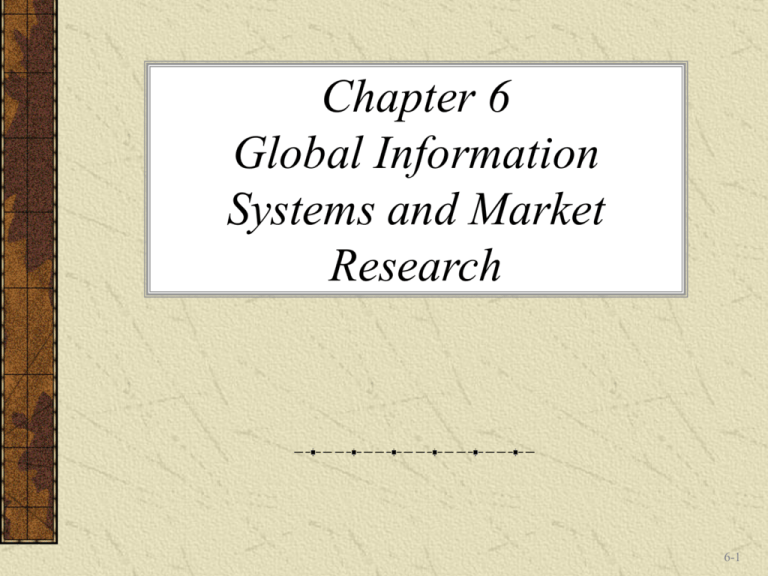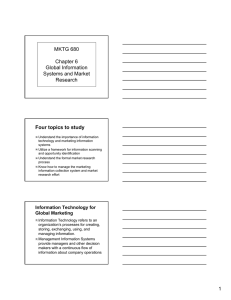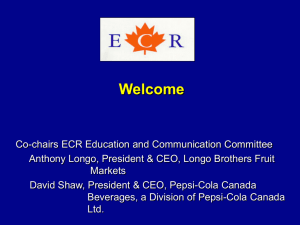Chapter 6 Global Information Systems and Market Research
advertisement

Chapter 6 Global Information Systems and Market Research 6-1 Introduction Understand the importance of information technology and marketing information systems Utilize a framework for information scanning and opportunity identification Understand the formal market research process Know how to manage the marketing information collection system and market research effort 6-2 Globalisation of brands Re-branding with global brand names – Jif - Cif, Marathon - Snickers, etc – Unilever reducing portfolio from 1600 to 400 brands e.g., Citibank/corp 6-3 6-4 MASSIVE COST SO WHY BOTHER? •> international travel •World media channels •Regional / global HQ’s •Economies of scale packaging, PR, image, signs, etc. •International consistency & global reach 6-5 Information Technology for Global Marketing Information Technology refers to an organization’s processes for creating, storing, exchanging, using, and managing information. Management Information Systems provide managers and other decision makers with a continuous flow of information about company operations 6-6 Tools of MIS Intranet Electronic Data Interchange (EDI) Efficient Consumer Response (ECR) Electronic Point of Sale (EPOS) Data Warehouses 6-7 Customer Relationship Management New business model Philosophy that values two-way communication between company and customer Every point of contact with a consumer is an opportunity to collect data Can make employees more productive and enhance corporate profitability 6-8 Customer Relationship Management The major thing is, ‘One size fits all’ is not true. CRM is designed to support the sales process, and if I develop a system that works in the U.S., it might not work in Europe.” - Jim Dickie, Insight Technology Group 6-9 Privacy Safe Harbor Agreement establishes principles for privacy protection for companies that transfer data to the US from Europe – Purposes of the information collected and used – An ‘opt out’ option to prevent disclosure of personal information – Can only transfer information to 3rd parties that are in compliance with Safe Harbor – Individuals must have access to information 6-10 Information Subject Agenda The starting point for global marketing information system is identifying a list of subjects for which information is desired – Should be tailored to the needs and objectives of the company Two essential criteria – Is all the information subject areas relevant to a company with global operations – Categories should be mutually exclusive 6-11 Information Subject Agenda 6-12 Scanning Modes: Surveillance and Search Surveillance – Informal information gathering • VIEWING – general exposure to information • MONITORING – paying special attention and tracking a story as it develops Search – Formal information gathering • INVESTIGATION – seeking out secondary data • RESEARCH – conducting primary research 6-13 Avoiding Information Overload Global organizations need – Efficient, effective system to scan and digest published sources of information in all countries in which it conducts business – Daily scanning, translating, digesting, abstracting, and electronic input of information into MIS 6-14 Sources of Market Information Human sources – Executives based abroad are likely to have established communication with distributors, consumers, customers, suppliers, and government officials – Friends acquaintances, professional colleagues, consultants, and prospective employees 6-15 Formal Market Research Global Marketing Research is the projectspecific, systematic gathering of data in the search scanning mode on a global basis – Challenge is to recognize and respond to national differences that influence the way information is obtained 6-17 Steps in the Research Process Identifying the research problem Developing a research plan Collecting data Analyzing data Presenting the research findings 6-18 Int’l research considerations (emerging mkts) IN ADDITION TO THE USUAL PITFALLS Research norms may vary Local researchers: availability / quality Secondary data source reliability Totally different infrastructure, e.g., –Communications, transport, equipment, etc., –Employment: staffing costs / availability of field staff Socio-cultural differences, living standards, literacy, tribalism Political instability –Exchange rate fluctuations Security Legislation issues / corruption 6-21 Standardised / multi country research Direct comparisons between countries feasible Economies of scale senior management time research development, data processing, etc. Uniform quality control standards data collection, processing/analysis, confidentiality, etc, 6-22 6-23 Managing multi-country studies Using own staff only Using local agency only (Preferably international name) Using own staff + local agency 6-25 Identifying the Information Requirement What information do I need? – Existing Markets – customer needs already being served by one or more companies; information may be readily available – Potential Markets • Latent market – an undiscovered market; demand would be there if product was there • Incipient market – market will emerge as macro environmental trends continue Why do I need this information? 6-26 Overcoming the SRC Self-Reference Criterion occurs when a person’s values and beliefs intrude on the assessment of a foreign culture Must be aware of SRC’s – Enhances management’s willingness to conduct market research – Ensures that research design has minimal home-country bias – Increases management’s receptiveness to findings No right or wrong, just different 6-28 Are Latin Americans really Americans too? U.S. perception Latin American perception Turkish perception 6-29 Perception of Time Organization of work – U.S. – Latin America Organization of free time – U.S. – Latin America 6-30 How to avoid SCR: – Define the business problem according to culture, habits,norms in home market. – Define the business problem according to culture, habits,norms in foreign market. – Isolate the SCR influence in the problem and examine it carefully to see how it complicates the problem. – Refine the problem without the SCR influence and solve for the optimum business goal situation. 6-31 Ten Good Reasons to use export marketing research and take control of your export markets 1) Put yourself in the "driving seat" 2) Develop an efficient market entry strategy 3) Control overseas representatives 4) Increase your profits 5) Familiarize yourself with the market 6) Save time and money 7) Gain favor with potential customers 8) A comprehensive report 9) Expert help at hand 10) Double your budget 6-32 Developing A Research Plan Do we need quantitative or qualitative data? What is the information worth (versus what will it cost to collect)? What will it cost if we don’t get the information? What can be gained from the information? 6-33 Availability and Use of Secondary Data Availability of Data 8-4 Reliability of Data Comparability of Data Validating Secondary Data 6-35 Collecting Data (cont.) Primary Data Collection Methods – – – – – Survey research Interviews Consumer panels Observation Focus groups 6-36 Special Considerations for Surveys Benefits: – Data collection from a large sample – Both quantitative and qualitative data possible – Can be self-administered Issues – Subjects may respond with social desirability – Translation may be difficult • Use back and parallel translations to ensure accuracy and validity 6-37 Sampling A sample is a selected subset of a population that is representative of the entire population. – Probability samples – Non-probability samples 6-38 Analyzing Data Demand Pattern Analysis Income Elasticity Measurements Market Estimation by Analogy Time-series displacement Comparative Analysis Cluster Analysis 6-39 Presenting the Findings Report must clearly address problem identified in Step 1 Include a memo or executive summary of the key findings along with main report 6-40 Global Issues in Marketing Research Many country markets must be included Markets with low profit potential justifies limited research expenditures Data in developing countries may be inflated or deflated Comparability of international statistics varies greatly Limits created by cultural differences 6-41 Enhancing Comparability of Data Emic analysis – Ethnographic in nature – Studies culture from within – Uses cultures’ own meanings and values Etic analysis – From the outside – Detached perspective that is used in multicountry studies – Enhances comparability but minimizes precision 6-42 Looking Ahead Chapter 7 Segmentation, Targeting, and Positioning 6-43 Intranet A Private network Allows authorized company personnel (or outsiders) to share information electronically 24-Hour Nerve Center Return 6-44 Electronic Data Interchange Allows business units to: – Submit orders – Issue invoices – Conduct business electronically Transaction formats are universal Return 6-45 Efficient Consumer Response (ECR) This is in addition to EDI An effort for retailers and vendors to work closely on sock replenishment ECR can be defined as a joint initiative by members of a supply chain to work toward improving and optimizing aspects of the supply chain to benefit customers. Return 6-46 Electronic Point of Sale Gathers data at checkout scanners – Identifies product sales trends – Identifies how consumer preferences vary geographically Return 6-47 Data Warehouses Can help fine-tune product assortments for multiple locations Enhances the ability of management to respond to changing business conditions Return 6-48










